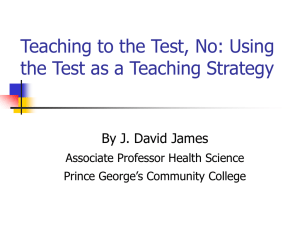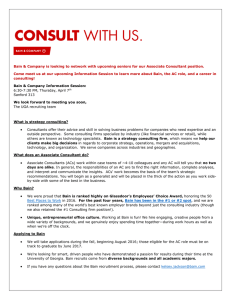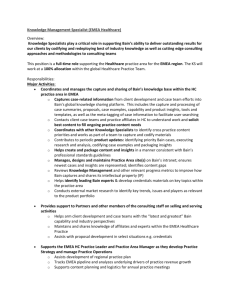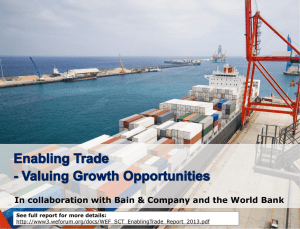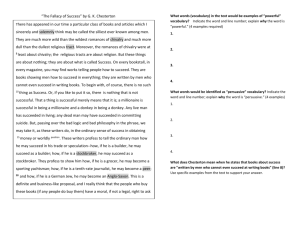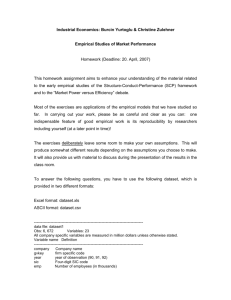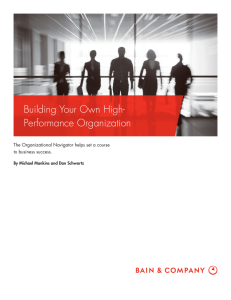Strategic Planning That Produces Real Strategy of time?
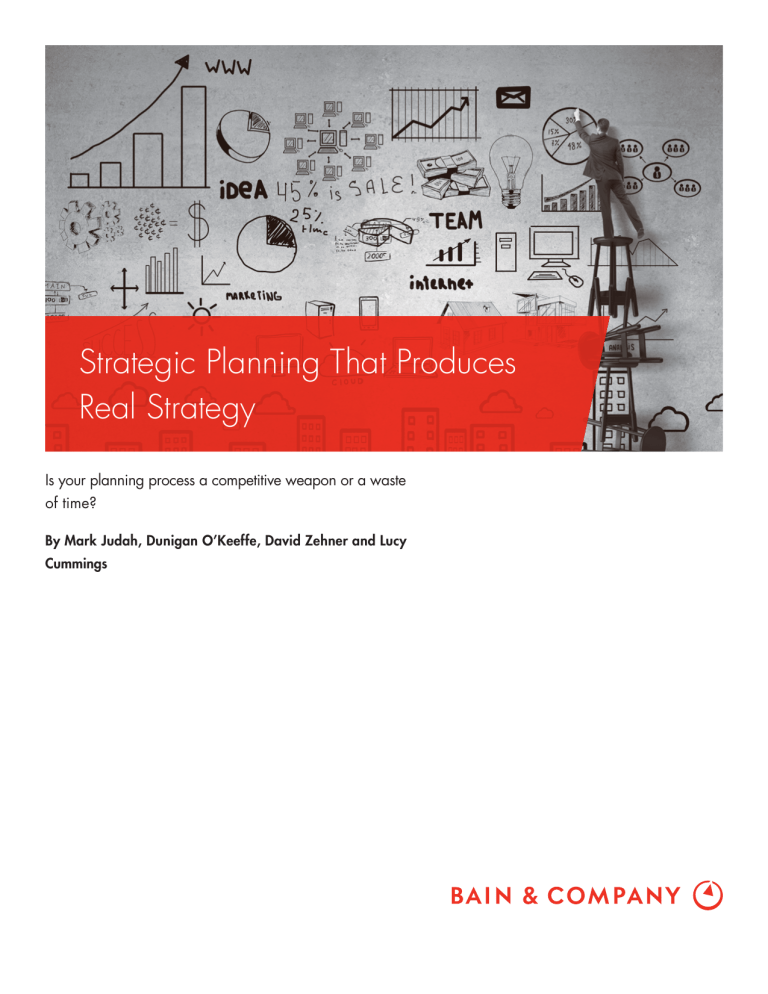
Strategic Planning That Produces
Real Strategy
Is your planning process a competitive weapon or a waste of time?
By Mark Judah, Dunigan O’Keeffe, David Zehner and Lucy
Cummings
Mark Judah is a Bain partner based in Sydney and a leader in the fi rm’s Strategy practice in the Asia-Pacifi c region. Dunigan O’Keeffe is a partner based in
Mumbai and leads Bain’s Asia-Pacifi c Strategy practice. David Zehner is the managing partner of Bain’s Australia and New Zealand offi ces and a Strategy practice leader. Lucy Cummings is a director in Bain’s Global Strategy practice based in Washington, DC.
Copyright © 2016 Bain & Company, Inc. All rights reserved.
Strategic Planning That Produces Real Strategy
The email arrives and your jaw clenches: It’s planning time again and there’s nothing you can do about it. No matter what else is on your plate, you know that the next month or so will be dominated by fi lling out templates and sitting through endless planning sessions. The irony is that you have some strategic ideas you’re really excited about but you fi gure you’ll have to work the back channels to get them in front of the right people. Previous experience has taught you that your company’s formal planning process is where the best ideas go to die.
ganization. Yet more than 60% of the executives we surveyed said they are satisfi ed with the very processes that lead to such mediocre strategy. Why? Some executives may have a different conception of what a good strategy looks like, but most have simply lowered their expectations.
They either believe their strategic planning process is as good as it’s ever going to get, or they feel that fi xing it would mean devoting even more time and effort to a diffi cult and tedious process—the last thing they want to do.
If this sounds familiar it’s because the typical strategic planning process is not delivering what it should at most companies. When we asked nearly 300 global executives to rate their company’s planning process, only one in three said that the strategy it produced met three vital criteria: bold ambition, adaptability in the face of changing market conditions and concrete guidance for management and the front line
(see Figure 1)
.
In our experience, few companies have a strong strategic planning process that is well-supported across the or-
The companies that produce great strategy take a different approach. They treat strategic planning as a critical capability that can and should be world class. It is as much a reason for their success as continuous improvement is for a low-cost manufacturer or service excellence is for a high-end retailer. These companies have invested in the people, processes and tools that allow them to identify the most important strategic priorities and adjust as needed to remain sharp and relevant as conditions change. The process creates time for focused strategic debates, dials up the cadence of decision making, and
Figure 1:
Few business executives believe their strategic planning process delivers a strong strategy
Percentage of respondents
100%
100%
80
60
40
-34%
-20%
-8%
20
0
All respondents
Ineffective process
Poor strategy design
Poor execution
Source: Bain survey of executives in North America, Western Europe and Asia, November 2014 (n=291)
1
-5%
32%
Poor adaptation
Effective process with strong design, execution & adaptation
Strategic Planning That Produces Real Strategy engages the organization at all levels to both think strategically and translate strategy into action. up with big, lofty ideas that they never ground in operational reality.
There is no one-size-fi ts-all approach. But we fi nd that world-class strategic planning incorporates fi ve key principles.
Principle 1: Strategic planning and budgeting are both essential, but they aren’t the same thing
Our research suggests that separating strategic planning and budgeting can improve the quality of strategy dramatically—as much as 40%
(see Figure 2)
. That’s because it forces leadership teams to schedule ample time for healthy debate about customer needs, competitive dynamics and business conditions. The most effective teams are careful to develop processes that link strategy to budgetary and operational planning. But the budget is always an outcome of the strategic aspiration, not the other way around.
A great strategy strikes a careful balance between bold ambition and practical implementation, but ambition leads the way. Too many companies confl ate strategy and budgeting in a single process that muddies the discussion and turns priorities on their head. Instead of the smartest, most ambitious strategic ideas determining where the company should invest to support both today’s growth engine and tomorrow’s, the organization spends an inordinate amount of time debating math and updating budget targets, resulting in only incremental improvement each year. At the other end of the spectrum, the top leaders at some companies devise strategy in a bubble, coming
Top leadership at one global resource company, for instance, focuses the fi rst part of each year on strategy development. This is the company’s chance to take stock— to train its sights outward and debate how markets are changing and what opportunities are emerging. Executives then spend the next few months on the practical implications of strategy, developing detailed budgets, operational plans and goals against key performance indicators.
Figure 2:
Separating strategy development from business planning and budgeting leads to better strategies
Does your company’s strategy deliver ...
3
2
Average score out of 5
5
4.1
4
2.9
4.1
3.0
1
0
A bold, inspiring, full-potential ambition
Clear choices on where to play and how to win
Strategy and budgeting separated
Source: Survey of executives in North America, Western Europe and Asia, November 2014 (n=291)
Not separated
2
4.1
2.9
The ability to evaluate and debate innovative alternatives and options
Strategic Planning That Produces Real Strategy
Budgeting remains a top priority, but it doesn’t get in the way of more expansive thinking.
Principle 2: Strategy amplifi es the voices of the front line and customers
Strategic planning is traditionally viewed as the realm of the C-suite executive. Planners and analysts set the agenda and top executives mull over alternatives, eventually meting out decisions that will guide action for the next
12 months or longer. The problem with this approach is that it isolates decision makers from the customers they are trying to serve. The company’s “doers”—those on the front line who execute strategy—are separated from the
“thinkers”—those who make decisions. Not surprisingly, this very often leads to strategy that lacks real customer insight and is exceptionally diffi cult to execute. allocating the largest share of dollars, time and even talent against them. It should encourage the company to staff “big jobs with big people”—recruiting the best performers from the lower-value areas where they may have become entrenched. Strategy isn’t fi guring out how to make the most of every opportunity but a rigorous exercise to determine how the company can redeploy trapped resources and overwhelm the opportunities that really matter.
Principle 4: Don’t let the earth’s rotation around the sun determine when you make decisions
The most effective strategic development processes amplify the voice of the customer. They tap the best thinking of those closest to the market by establishing deep ties to the people on the front line who deliver the customer promise every day. Instead of pushing a fully formed strategy down through the organization, these processes incorporate the voice of the customer and translate it into a set of behaviors that the front line can embrace wholeheartedly. This eliminates distance between the C-suite and customers and builds the kind of organizational will that leads to strong execution.
Principle 3: Resource allocation is purposely undemocratic
Many planning processes default to “last year plus” when allocating resources across the organization. Planners spread investment around democratically, divvying up precious resources among every unit that has received an allocation in the past with little regard to real future potential. As each unit lobbies on its own behalf, it only seems “fair” to reward satisfactory performance.
Most strategic planning processes leave little opportunity for free-fl owing debate outside of the annual planning window, which is typically highly formal and jam-packed with other priorities. Many important issues receive minimal airtime or never see the light of day. This tends to encourage a parallel, informal process in which leaders make many critical decisions ad hoc, infl uenced by those with the loudest voices—not necessarily those with the best ideas or the most critical priorities.
Keeping pace with today’s dynamic markets requires breaking the stranglehold of the typical annual planning cycle. Our research shows that companies are 60% more likely to make timely, high-stakes decisions if business needs, not the calendar, determine the cadence of their strategic planning process. That often means creating a continuous, issues-based strategic agenda that runs throughout the year. Top decision makers need regularly scheduled opportunities for real, no-holds-barred debates on strategic alternatives ranked by dollar value and urgency.
This avoids one-and-done thinking and promotes a more fl exible cycle in which critical initiatives are deployed, monitored and adjusted in real time.
But a winning strategy demands ruthless prioritization; satisfactory is not good enough. The planning process should be biased toward defi ning the company’s most critical future growth opportunities and purposely
One large software company discovered the limitations of a static, calendar-based planning process several years ago when market changes during the year created a sudden disconnect between strategic needs and the resources required to pursue them. A year-end shortfall forced the company to make a number of decisions that were both painful and distracting. The solution was
3
Strategic Planning That Produces Real Strategy to create a process that set ambitious multiyear goals but then institute a continuous planning forum to debate and resolve the highest value issues on a real-time basis—tracking, tuning and reconciling resource allocation along the way. The new process created a rolling, decision-focused dialogue around the most critical strategic and operational issues facing the company.
And it enabled the organization to respond to changes in the market or competitive landscape more quickly and effectively.
Principle 5: Leaders focus on the most important decisions and simplify the rest
robust strategic decisions. Leadership can’t afford a planning process layered with bureaucratic complexity that just diverts focus from what really matters: fi guring out how to serve customers better than the competition, both now and in the future.
Conclusion
A world-class strategic planning capability based on these fi ve principles eliminates the noise from the planning process, creating essential time for debate and distilling the agenda down to the critical issues that will truly propel the company to sustained profi tability and leadership.
How do companies create time for a regular cadence of strategic debate? They radically simplify the leadership agenda to exclude many of the “business as usual” issues that tend to drag strategic discussions into the weeds.
That means empowering the fi nance function and business units to make decisions about budgeting and operational issues that are important but can be handled just as effectively by capable staff.
However, hardwiring a strategic capability at any company is a multiyear, multiphase process. Through our client work and research, we have found that many companies are still struggling with the basics. And not every organization will want—or need—to develop a world-class capability across the board. Market dynamics, cultural issues and other organization-specifi c considerations will likely determine what the end state should look like for any particular company.
Companies also need to zero-base the planning process itself. One particularly noteworthy fi nding in our research was that C-level executives were 37% more likely to declare satisfaction with their company’s strategic planning process than others we surveyed. The reason: Top leaders are very often isolated from the worst of the annual planning ritual—the thousands of hours spent fi lling out templates or preparing the boss for meetings with thick binders of information. Zero-basing forces leaders to imagine the process with a clean sheet of paper and determine what information is truly critical to making
A critical fi rst step is self-diagnosis: Is your strategic planning process an annual ritual that your organization reluctantly endures? Or is it a means to empower the entire company—from the front line to the C-suite— to dream big, define a mission and drive toward it relentlessly? At a time when unprecedented turbulence in global markets requires bold vision, world-class execution and quick adaptation, the answer can be a game changer.
It may spell the difference between settling for satisfactory underperformance or stretching toward full potential.
4
Shared Ambit ion, True Re sults
Bain & Company is the management consulting fi rm that the world’s business leaders come to when they want results.
Bain advises clients on strategy, operations, technology, organization, private equity and mergers and acquisitions.
We develop practical, customized insights that clients act on and transfer skills that make change stick. Founded in 1973, Bain has 53 offi ces in 34 countries, and our deep expertise and client roster cross every industry and economic sector. Our clients have outperformed the stock market 4 to 1.
What sets us apart
We believe a consulting fi rm should be more than an adviser. So we put ourselves in our clients’ shoes, selling outcomes, not projects. We align our incentives with our clients’ by linking our fees to their results and collaborate to unlock the full potential of their business. Our Results Delivery ® process builds our clients’ capabilities, and our True North values mean we do the right thing for our clients, people and communities—always.
Key contacts in Bain & Company’s Global Strategy practice
Americas Ouriel Lancry in Chicago ( ouriel.lancry@bain.com
)
Lucy Cummings in Washington, DC (lucy.cummings@bain.com)
Asia-Pacifi c Dunigan O’Keeffe in Mumbai (dunigan.okeeffe@bain.com)
Mark (mark.judah@bain.com)
Europe,
Middle East and Africa
James Allen in London (james.allen@bain.com)
Nicolas Bloch in Brussels (nicolas.bloch@bain.com)
James Hadley in London (james.hadley@bain.com)
For more information, visit www.bain.com



